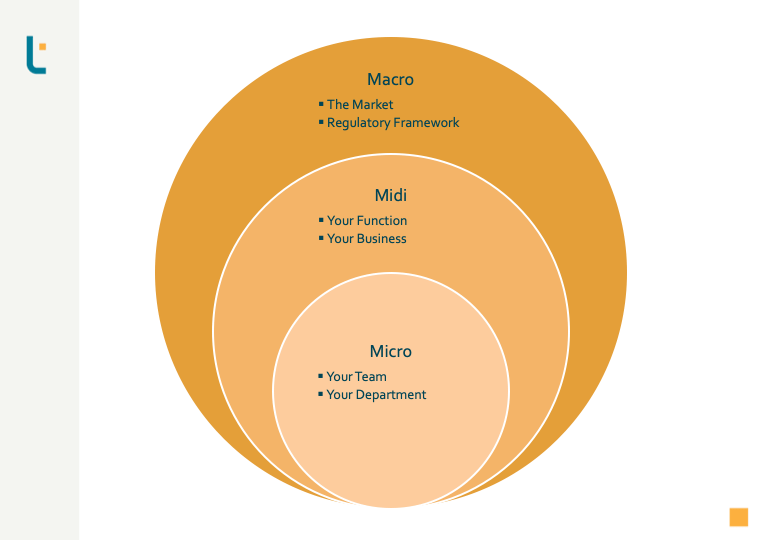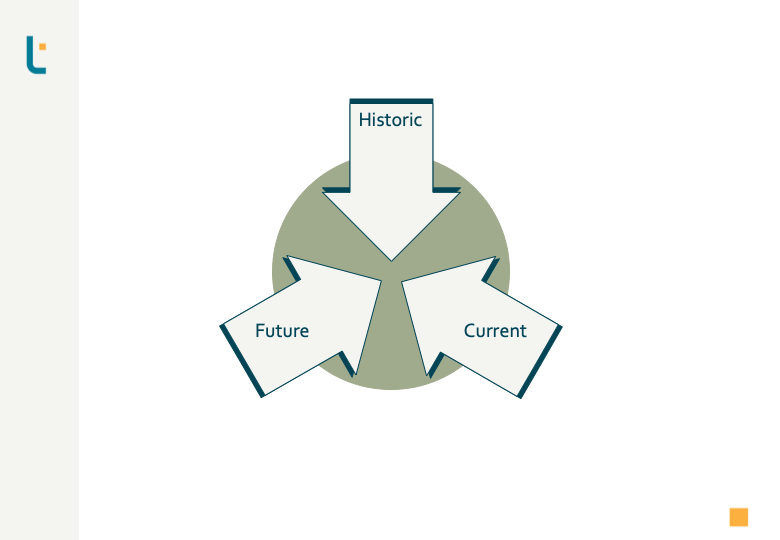Finance Transformation: Understand The Context to Secure Excellence

AUTHOR: JENNIFER LOUGHRIDGE
PRINCIPAL CONSULTANT
Jennifer is a Senior Executive Finance professional with 22+ years of global experience. She specialises in Finance Transformation, ESG and Continuous Improvement, with particular expertise in Strategy, Performance Management, Business Partnering, Commercial Decision-Making, Corporate Governance and Valuation.
In our last post in this nine-part series, we looked at Choose The Lever. There, we covered the levers available to achieve targets that inform your solution selection in the design phase.
This post will focus on the sixth of the nine steps: Understand the Context. First, we’ll examine the importance of understanding what’s happening around you. Then, we will introduce the lenses you can use to help you identify what could impact your finance transformation.
Why Is Context Important?
If you have been following the Loughridge Transformations method, by now, you will have covered the following steps:
-
Strategy: How to Supercharge Finance Transformation
The Loughridge Transformations approach to strategy.
-
Finance Functional Fit: The Most Critical Scope Definition You Need
The Loughridge Transformations method of determining the Finance Functional Fit – the most critical scope definition you need.
-
Baseline Definition – A Reliable Assessment Model for the Finance Function
Learn how Loughridge Transformations effectively evaluates baseline data to achieve successful Finance Transformation.
-
Define the Future – Target Setting & Benchmarking
The Loughridge Transformations structured approach to working with benchmarks and establishing targets for Finance Transformation.
-
Choose The Lever for Successful Finance Transformation
The Loughridge Transformations method of Finance Transformation: Choose The Lever – discover the tools and strategies that will set you on the path to achieving targets.
It is now time to sit up and look at the environment with open eyes and ears. To ensure the finance transformation is on budget and schedule, you’ll need to know the context in which you operate. After all, nothing takes place in isolation. That being said, a couple of lenses can help tackle this thoroughly. The main aim here is to uncover things that will increase the resources – time and/or effort – needed to generate your desired outcome. Sometimes, this can be relatively simple, but there are times when having an experienced external eye can be a catalyst for finding your way through.
Micro-Midi-Macro
The Micro-Midi-Macro lens is the first tool we use at Loughridge Transformations to help us understand the context. It is not just straightforward but also powerful:

First, look at the immediate environment of the team or department impacted by the project under consideration. We call this “micro”. This includes understanding the team’s structure, dynamics, and current workload. Second, the thinking should broadly encompass the whole function and company-wide activities – “midi”. This involves considering the project’s impact on the entire department or company, including resource allocation and potential disruptions. Lastly, look externally and consider what is happening in the market and the regulatory framework – “macro”. This step involves understanding the broader industry and regulatory context and how these factors might influence the project. Reviewing “harder” content items – like other projects or known activities – is essential. However, softer human elements are also critical.
Historic-Current-Future
The second lens we use to understand the context is similarly straightforward. It is no more complicated than considering what has happened in the past – sometimes overlooked – and thinking about what is happening now or is scheduled to occur.

Diagnostic Tools
As accredited AIM practitioners, we naturally prefer the methodology and tools used at IMA. We will talk about project and change management in a subsequent blog. Different people, of course, have different inclinations for particular approaches or methods. We can also help you understand your teams’ and sponsors’ perceptions and personal preferences. What is crucial, however, is to find something that works for you and your organisational culture and is comprehensive enough to meet your needs.
Regulatory Compliance – A Real-Life Example
The Background
Our chosen example will focus on how an organisation adapts to new regulatory compliance and the journey to get there. But first, we’ll look at why it’s essential to understand the context at this stage.
We assume that your organisation is mid- to large-sized and is listed on one or more major stock exchanges, for example, London, New York, or Amsterdam. As a result of some new stock exchange (reporting and disclosure) regulations, your organisation needs to be fully compliant within a given timeframe. In this example, you are leading the project.
It is a fairly classic case with which many will be familiar. New external regulations are due to be introduced. They are mandatory and require compliance, assuming the organisation continues operating as usual. The Effectiveness Lever is at the forefront because of the requirements for accuracy. On-time delivery is also of the essence. You identified that following the Loughridge Transformations method.
Applying the Context Lenses
Micro
Using the Micro-Midi-Macro lens, you begin with the “micro” context – the immediate environment. First of all, you start by talking to the Reporting Leads. You learn that their teams are smaller, following some re-organisation of activities to improve efficiency. As a result, they are now operating with limited spare capacity, and absorbing these new reporting and disclosure activities will prove challenging. Next, some of these activities are somewhat different in nature compared to the existing ones. The current analysts are not likely to have the required skill set. You also take the time to check with the Reporting Leads which smaller improvement initiatives are ongoing or planned in their area. It is an ideal time to assess those teams’ human factors and personal preferences to allow you, as project lead, to tailor the project and change activities that are to come.
Midi
Next, you look at the “midi” context – function and business level. You find that there are currently several large-scale and critical projects running. As a result, resources may be limited. It also triggers the thinking that you may be unaware of other smaller “touch-point” projects.
With these warning signs, you know you need to map this out thoroughly by looking at the organisation and systems affected by this change. As this is a reporting and disclosure regulation, you will want the analysts to effectively and accurately produce the required data quickly and consistently. Consequently, you investigate the organisation’s ERP and IT systems. You learn that there are already significant ongoing improvements to the ERP and realise that installation will require a co-ordinated implementation approach, including streamlined, targeted communication and change activities, given that many of the same people will be impacted.
Unfortunately, the spider’s web does not stop there. You discover that you will need changes to Customer and Vendor Data in your ERP system to report the required data accurately. A data team is already working on eliminating duplicate or dormant vendor and supplier records in the ERP system. They are also looking into simplifying and standardising the master data attributes. Your input into their project will be vital to complying with the regulations.
Macro
Lastly, you investigate the “macro” context – what is happening externally. Your project is externally driven, and you must monitor the latest developments. Given its regulatory compliance nature, you know that you will need to connect with the Tax department. You find that there is a global initiative to simplify and streamline tax data with multiple connecting points to your project. This macro context is crucial as it helps you understand the broader industry trends and regulatory changes that might impact your project. You have discovered yet another piece to which you must stay close.
At each stage – applying the Historic-Current-Future lens, you have been asking what:
- has happened?
- is happening?
- will happen?
In this way, you get a rich enough overview to mitigate and manage the risks to your delivery.
Is It So Complex – Really?
It may seem that we have intentionally dreamed up so many inter-connected projects for this example. Indeed, it demonstrates how complex a “must-do” project can become and why it is vital to understand the context. This kind of complexity may be recognisable within your organisation. However, there was no dreaming, intentional or otherwise! This scenario is taken from real-life experience in a global multi-national organisation and needed no enhancement as an example!
At first glance, mandatory compliance projects may seem straightforward to deliver. However, our example shows the complexity and that experienced and skilled project management and subject-matter knowledge are tremendous advantages. If you do not have that in-house, bringing in support and resources from someone like Loughridge Transformations can be enormously valuable.
Where Next?
Last but not least, if you have worked through the Loughridge Transformations method, what you are looking for in project sponsorship will be more evident. All the insights you have gathered in this and the earlier steps will help you determine who the right sponsor is and what you might need from them. We will look more into this topic in the next blog.
Interested in More Finance Transformation?
Our next post will focus on the seventh step: Prepare for Delivery. We will cover the importance of good project and change management in delivering Finance Transformation.
Did you miss some of the other posts in this series? Find them here:
-
Nine Steps to Finance Transformation
An introduction to a series of blog posts on nine scalable and modular steps to deliver successful and sustainable Finance Transformation.
-
Strategy: How to Supercharge Finance Transformation
The Loughridge Transformations approach to strategy.
-
Finance Functional Fit: The Most Critical Scope Definition You Need
The Loughridge Transformations method of determining the Finance Functional Fit – the most critical scope definition you need.
-
Baseline Definition – A Reliable Assessment Model for the Finance Function
Learn how Loughridge Transformations effectively evaluates baseline data to achieve successful Finance Transformation.
-
Define the Future – Target Setting & Benchmarking
The Loughridge Transformations structured approach to working with benchmarks and establishing targets for Finance Transformation.
-
Choose The Lever for Successful Finance Transformation
The Loughridge Transformations method of Finance Transformation: Choose The Lever – discover the tools and strategies that will set you on the path to achieving targets.
-
Finance Transformation: Understand The Context to Secure Excellence
Examining the importance of understanding what’s happening around you and identifying what could impact your Finance Transformation.
-
Power Up the Design and Ensure Robust Finance Transformation
The Loughridge Transformations approach to delivering the design phase of projects.
-
Deployment for Finance Transformation: Ensuring a Successful Go-Live
The Loughridge Transformations approach to the implementation phase of projects.
-
Sustain the Change: Finance Transformation to Last
The Loughridge Transformations way to actively reinforce the new practices and monitor their impact to pave the way to drive your Finance Transformation forward
-
Reviewing the Nine Steps to Finance Transformation
A summary of the series of blog posts on nine scalable and modular steps to deliver successful and sustainable Finance Transformation.
If you would like to speak with one of our consultants to discuss the above, please feel free to contact us!
Alternatively, take a look at our most popular blog posts:
Or are you looking for something else? Here’s what we have been blogging about recently:
Agile Analytics Associates Automation Behaviours Building Trust Business-Partnering CFO Remit Change Management Coaching Collaboration Continuous Improvement Control Design Corporate Governance Data Deployment Digital ERP ESG Finance Function Finance Transformation Implementation Migration Off-Shoring Organisation Organisation Design Process Process Design Process Governance Process Improvement Process Performance Productivity Project Management Readiness Risk & Controls Skills Solution Selection sponsorship Standard Organisational Model Strategy Systems Systems Design Technology Transformation Virtual Working
